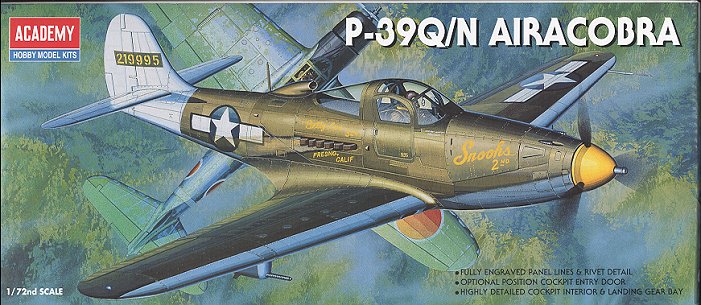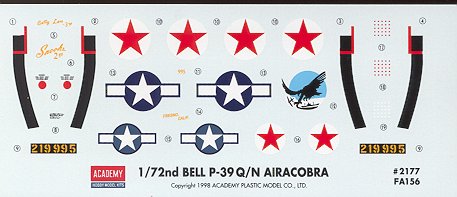
|
KIT: |
Academy 1/72 P-39N/Q Airacobra |
|
KIT # |
2177 |
|
PRICE: |
$9.00 |
|
DECALS: |
2 aircraft |
|
REVIEW & |
|
|
NOTES: |
|

|
HISTORY |
The story of Bell's P-39 Airacobra is one that has been replayed many times since the end of WWII, most recently with the F-5 and F-20. It is the story of a light fighter. A light fighter is one that is basically designed for short range, local air defense and control. The idea is to build an aircraft that is very fast in initial climb and one that can quickly get to the enemy. It should have enough fire-power to be able to bring down the attacking aircraft and be nimble enough to get the upper hand in combat.
Those were the requirements for the P-39 and those requirements were pretty well met with the prototype. It was fast, has superb climbing ability, and was quite nimble. It also had a short range and as a prototype, was not burdened down with armor and armament. It was also designed for a turbocharged engine to allow it to operate well at high altitudes.
Alas, the Army started messing with it. They wanted to get rid of the troublesome turbocharging. There goes high altitude performance and some of the speed. It had armament and armor plating added, which also slowed the plane down. It was further burdened with external drop tanks and additional requirements to carry bombs. The result was an aircraft that was still pretty nimble, still pretty fast climbing, but was a total pooch above 15,000 feet, thanks to having a non-turbocharged engine. It was still short ranged thanks to having less than 100 gallons of on-board fuel without external tanks. After all, it was basically a point-defense fighter.
Despite all its shortcomings, there was a war on the way so instead of allowing Bell to build the fighter it wanted (which was the P-63) and stopping production of the P-39, it was continually modified. At low altitudes, it was a superb aircraft, unfortunately most combat took place where the Airacobra was at a distict disadvantage. However, with the 37mm nose cannon, it was an excellent ground attack plane. Of the nearly 10,000 built during the war, half of that went to the Soviets who liked the heavy armament and used the aircraft as a low level fighter with much success.
|
THE KIT |

Academy's P-39 is quite reminiscent of the Heller P-39, though it is a more modern mold with engraved panel lines, an improved interior, two sets of exhaust, an additional bomb load, and a cockpit door that can be displayed open. Interestingly, there are throttle quadrants on both doors of this kit. Must be for either right or left handed pilots! There are also two separate spinners depending on if your P-39 has a long or short barreled cannon.
There is acceptable detail in the main wheel wells and none in the nose well. The wheels look like those from toys as there is no wheel detail at all. Perhaps this is prototypical. The nose wheel is molded on with the main gear. This kit will need quite a bit of nose weight to keep it from being a tail sitter. You also have the option of wing guns or underwing gun gondolas
 The instructions
are more than adequate, giving a short history, parts location, and an 8
step construction sequence. It shows relevant colors needed in each step as well
as which parts are for which version of the aircraft. The decal placement guide
gives FS numbers for external colors. The decal sheet itself is for two
aircraft. One is a P-39N of the 71st TRS in New Guinea circa 1944. The other for
a Russian P-39Q of the 17th IAP again , in 1944. The Russian one has a nice, big
eagle marking on the nose while the New Guinea version has a white tail and wing
leading edges as was typical in that theater.
The instructions
are more than adequate, giving a short history, parts location, and an 8
step construction sequence. It shows relevant colors needed in each step as well
as which parts are for which version of the aircraft. The decal placement guide
gives FS numbers for external colors. The decal sheet itself is for two
aircraft. One is a P-39N of the 71st TRS in New Guinea circa 1944. The other for
a Russian P-39Q of the 17th IAP again , in 1944. The Russian one has a nice, big
eagle marking on the nose while the New Guinea version has a white tail and wing
leading edges as was typical in that theater.
No matter which option the builder chooses, this will make into a very nice model when finished. I'll let others comment on the accuracy of the kit dimensionally. It looks very much like what it is supposed to be, and with a number of aftermarket decal sheets available for this kit, you should be able to find one you like.
Review kit courtesy of me and my wallet!
If you would like your product reviewed fairly and quickly by a site that has over 1,400 visits a day, please contact me or see other details in the Note to Contributors.